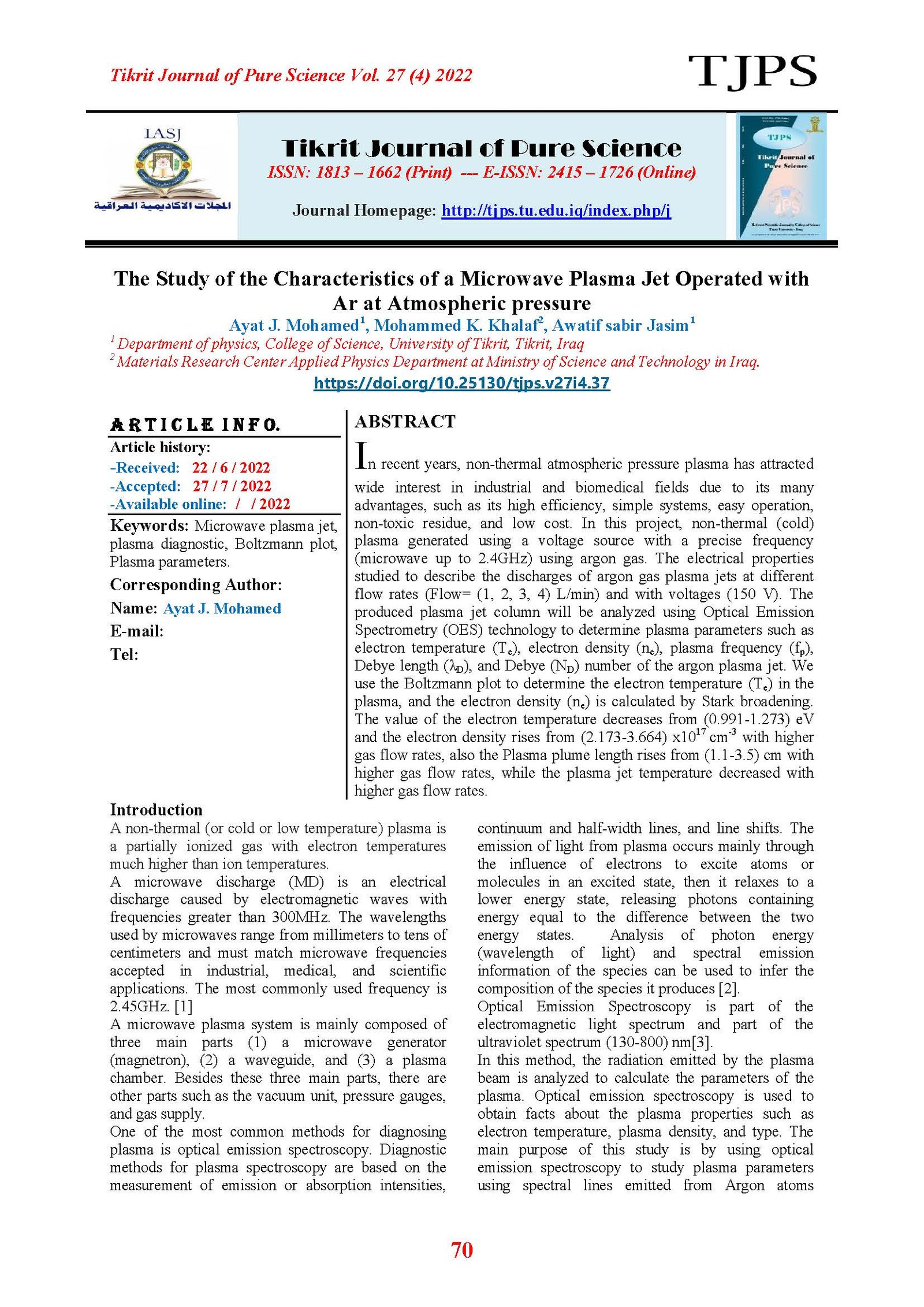The Study of the Characteristics of a Microwave Plasma Jet Operated with Ar at Atmospheric pressure
Main Article Content
Abstract
In recent years, non-thermal atmospheric pressure plasma has attracted wide interest in industrial and biomedical fields due to its many advantages, such as its high efficiency, simple systems, easy operation, non-toxic residue, and low cost. In this project, non-thermal (cold) plasma generated using a voltage source with a precise frequency (microwave up to 2.4GHz) using argon gas. The electrical properties studied to describe the discharges of argon gas plasma jets at different flow rates (Flow= (1, 2, 3, 4) L/min) and with voltages (150 V). The produced plasma jet column will be analyzed using Optical Emission Spectrometry (OES) technology to determine plasma parameters such as electron temperature (Te), electron density (ne), plasma frequency (fp), Debye length (λD), and Debye (ND) number of the argon plasma jet. We use the Boltzmann plot to determine the electron temperature (Te) in the plasma, and the electron density (ne) is calculated by Stark broadening. The value of the electron temperature decreases from (0.991-1.273) eV and the electron density rises from (2.173-3.664) x1017 cm-3 with higher gas flow rates, also the Plasma plume length rises from (1.1-3.5) cm with higher gas flow rates, while the plasma jet temperature decreased with higher gas flow rates.
Article Details

This work is licensed under a Creative Commons Attribution 4.0 International License.
Tikrit Journal of Pure Science is licensed under the Creative Commons Attribution 4.0 International License, which allows users to copy, create extracts, abstracts, and new works from the article, alter and revise the article, and make commercial use of the article (including reuse and/or resale of the article by commercial entities), provided the user gives appropriate credit (with a link to the formal publication through the relevant DOI), provides a link to the license, indicates if changes were made, and the licensor is not represented as endorsing the use made of the work. The authors hold the copyright for their published work on the Tikrit J. Pure Sci. website, while Tikrit J. Pure Sci. is responsible for appreciate citation of their work, which is released under CC-BY-4.0, enabling the unrestricted use, distribution, and reproduction of an article in any medium, provided that the original work is properly cited.
References
[1] Lebedev, Y. A.(2010, November).Microwave
discharges: generation and diagnostics. In Journal of
physics: conference series (Vol. 257, No. 1, p.
012016). IOP Publishing.
[2] Ebdon, L., Fisher, A. S., & Hill, S. J. (1998). An
introduction to analytical atomic spectrometry. John
Wiley & Sons.
[3] Thirumdas, R., Kothakota, A., Annapure, U.,
Siliveru, K., Blundell, R., Gatt, R., & Valdramidis, V.
P. (2018). Plasma activated water (PAW): Chemistry,
Physico-chemical properties, applications in food and
agriculture. Trends in food science & technology, 77,
21-31.
[4] Aadim, K. A., & Hussein, H. I. (2021,
November). Determination of plasma parameters of
pin-plate discharge in nitrogen. In AIP Conference
Proceedings (Vol. 2372, No. 1, p. 130015). AIP
Publishing LLC.
[5] Zhu, X. M., Pu, Y. K., Balcon, N., & Boswell, R.
(2009). Measurement of the electron density in
atmospheric-pressure low-temperature argon
discharges by the line-ratio method of optical
emission spectroscopy. Journal of Physics D: Applied
Physics, 42(14), 142003.
[6] Balcon, N., Aanesland, A., & Boswell, R. (2007).
Pulsed RF discharges, glow, and filamentary mode at
atmospheric pressure in argon. Plasma Sources
Science and Technology, 16(2), 217.
[7] Dong, L., Qi, Y., Zhao, Z., & Li, Y. (2008).
Electron density of an individual micro discharge
channel in patterns in a dielectric barrier discharge at
atmospheric pressure. Plasma Sources Science and
Technology, 17(1), 015015.
[8] Aadim, K. A., Hussain, A. A., Abdalameer, N. K.,
Tawfeeq, H. A., & Murbat, H. H. (2015). Electron
temperature and density measurement of a plasma jet
in atmospheric pressure. Int. J. Nov. Res. Phys. Chem.
Math, 2, 28-32.
[9] Makabe, T., & Petrovic, Z. L. (2006). Plasma
electronics: applications in microelectronic device
fabrication. CRC Press.
[10] Boyd, T. J., Boyd, T. J. M., & Sanderson, J. J.
(2003). The physics of plasmas. Cambridge
University Press.
[11] Mieno, T. (Ed.). (2016). Plasma Science and
Technology: Progress in the Physical States and
Chemical Reactions. BoD–Books on Demand.
[12] Brockhaus, A., Borchardt, C., & Engemann, J.
(2015). Langmuir probe measurements in commercial
plasma plants. Plasma Sources Science and
Technology, 3(4), 539.
[13] Aadim, K. A., & Salman, M. O. (2017).
Investigation of intensity distribution by Image
analysis for DC discharge. Advances in
Environmental Biology, 11(3), 9-15.
[14] Kramida, A., Ralchenko, Yu., Reader, J., and NIST ASD Team (2021). NIST Atomic Spectra Database (ver. 5.9), [Online]. Available: https://physics.nist.gov/asd [2022, June 17]. National Institute of Standards and Technology, Gaithersburg, MD. DOI: https://doi.org/10.18434/T4W30F [15] Szymański, Z., & Kurzyna, J. (1994). Spectroscopic measurements of laser-induced plasma during welding with CO2 laser. Journal of Applied Physics, 76(12), 7750-7756.
[16] Tu, X., Chéron, B. G., Yan, J. H., & Cen, K. F. (2007). Electrical and spectroscopic diagnostic of an atmospheric double arc argon plasma jet. Plasma Sources Science and Technology, 16(4), 803.
[17] F. Hall and B. Hill. (2000). "Introduction to gas discharges," PlasmaSources Sci. Technol., vol. 9, pp. 517-527. [18] Moon, S. Y., Choe, W., Uhm, H. S., Hwang, Y. S., & Choi, J. J. (2002). Characteristics of an atmospheric microwave-induced plasma generated in ambient air by an argon discharge excited in an open-ended dielectric discharge tube. Physics of Plasmas, 9(9), 4045-4051.
